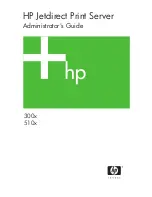
To
attach
non-USB
devices
to
the
server,
use
the
cables
that
come
with
the
devices
and
connect
the
cables
to
the
appropriate
ports
on
the
server
(see
Chapter
3,
“I/O
connectors,”
on
page
35).
To
attach
a
USB
device
to
the
server,
use
the
cable
that
comes
with
the
device
and
connect
the
cable
to
one
of
the
four
USB
ports
on
the
server
(see
“Universal
Serial
Bus
connectors”
on
page
36).
v
If
you
want
to
attach
a
keyboard
or
mouse
to
this
server,
you
must
use
a
USB
keyboard
or
a
USB
mouse.
After
installing
a
USB
keyboard,
you
might
need
to
use
the
Configuration/Setup
Utility
program
to
enable
keyboardless
operation
and
prevent
POST
error
message
301
from
being
displayed
during
startup.
For
information
about
the
Configuration/Setup
Utility
program,
see
the
User’s
Guide
on
the
IBM
Eserver
Documentation
CD.
v
You
might
want
to
create
update
diskettes
that
contain
the
latest
baseboard
management
controller
firmware
and
BIOS
code.
Use
an
external
USB
diskette
drive
if
you
want
to
attach
a
diskette
drive
to
this
server.
For
information
about
updating
the
baseboard
management
controller
firmware
and
BIOS
code,
see
the
User’s
Guide
on
the
IBM
Eserver
Documentation
CD.
Depending
on
the
options
that
you
installed,
after
cabling
the
server,
you
might
need
to
run
the
Configuration/Setup
Utility
program
to
update
the
server
configuration.
For
more
information,
see
“Updating
the
server
configuration”
and
the
User’s
Guide
on
the
IBM
Eserver
Documentation
CD.
Updating
the
server
configuration
When
you
start
the
server
for
the
first
time
after
you
add
or
remove
an
internal
option
or
an
external
SCSI
device,
you
might
see
a
message
telling
you
that
the
configuration
has
changed.
The
Configuration/Setup
Utility
program
automatically
starts
so
that
you
can
save
the
new
configuration
information.
For
more
information,
see
the
section
about
configuring
the
server
in
the
User’s
Guide
on
the
IBM
Eserver
Documentation
CD.
Some
options
have
device
drivers
that
you
need
to
install.
See
the
documentation
that
comes
with
the
option
for
information
about
installing
any
required
device
drivers.
The
server
comes
with
at
least
one
microprocessor
installed
on
the
system
board.
If
you
have
installed
an
additional
microprocessor,
the
server
can
now
operate
as
an
SMP
server.
Therefore,
you
might
need
to
upgrade
the
operating
system
to
support
SMP.
For
additional
information,
see
the
operating-system
documentation.
If
the
server
has
an
optional
RAID
adapter
and
you
have
installed
or
removed
a
hard
disk
drive,
see
the
documentation
that
comes
with
the
RAID
adapter
for
information
about
configuring
disk
arrays.
To
configure
the
integrated
Gigabit
Ethernet
controllers,
see
the
section
about
configuring
the
Gigabit
Ethernet
controllers
in
the
User’s
Guide
on
the
IBM
Eserver
Documentation
CD.
If
you
have
just
installed
a
Remote
Supervisor
Adapter
II
to
manage
the
server
from
a
remote
location,
see
the
documentation
that
comes
with
the
adapter
for
information
about
setting
up
and
configuring
the
adapter
and
using
the
adapter
to
manage
the
server
remotely.
34
326
Type
8848:
Option
Installation
Guide
Summary of Contents for totalstorage 326
Page 1: ...326 Type 8848 Option Installation Guide ERserver...
Page 2: ......
Page 3: ...326 Type 8848 Option Installation Guide ERserver...
Page 6: ...Power cords 42 Index 45 iv 326 Type 8848 Option Installation Guide...
Page 14: ...xii 326 Type 8848 Option Installation Guide...
Page 58: ...44 326 Type 8848 Option Installation Guide...
Page 62: ...48 326 Type 8848 Option Installation Guide...
Page 63: ......
Page 64: ...Part Number 25K8176 Printed in USA 1P P N 25K8176...
















































